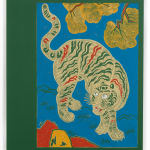-
Artworks
Kour Pour UK, b. 1987
K-Pop, 2022Block printed on canvas using acrylic and oil43 x 38 x 2 in
109.2 x 96.5 x 5.1 cm8608Further images
-
(View a larger image of thumbnail 1
)

-
(View a larger image of thumbnail 2
)

-
(View a larger image of thumbnail 3
)

-
(View a larger image of thumbnail 4
)

-
(View a larger image of thumbnail 5
)

-
(View a larger image of thumbnail 6
)

-
(View a larger image of thumbnail 7
)

-
(View a larger image of thumbnail 8
)

This painting by Los Angeles-based artist Kour Pour fosters the iconography of Korean minhwa, or folk painting. Images of tigers and magpies are common within the minhwa tradition, as are...This painting by Los Angeles-based artist Kour Pour fosters the iconography of Korean minhwa, or folk painting. Images of tigers and magpies are common within the minhwa tradition, as are images of flowers, mountains, birds, insects, and other animals. Pour mobilizes these visual elements in his K-Pop series as a means of creating new images rooted in contemporary cultural exchange. The different personalities perceptible in the countenances of the tigers in the different paintings are connected to the different faces or masks one might choose to wear as a form of code switching when living in between cultures. Pour intends the softened color palette as a nod towards early Modernist abstract painters such as Miró, Calder, and the Bauhaus artists, who used bright, solid, primary colors in their work. Many of those same artists also employed childlike imagery that ignored the rules of perspective—techniques which are fundamental to the principles of minhwa painting. Pour lowers the temperature of his hues, bringing a softer, more natural sensibility into the painting. This muted palette eliminates the coldness and academicism associated with European Modernism and supplants it with a more nurturing, welcoming, global visual language that invites everyday subject matter and heartfelt exploration. Pour composes these paintings so that a large block of color occupies one side of the canvas. This compositional strategy is evocative of a page, indicating these images were borrowed from historical sources. Pour is an American citizen whose family heritage traces itself to the UK and Iran. His visual language extends across the globe, taking elements from a range of cultures similarly to how Persian carpets contain visual and symbolic references from every culture Persia traded with. “I'm interested in using images that are "outside" of my perceived culture,” Pour says. “I'm looking for a type of artistic freedom that has been granted to non-minority artists. My world is much bigger than my cultural identity. I'm making work from my experiences of being in between.”2of 2 -
(View a larger image of thumbnail 1
)







